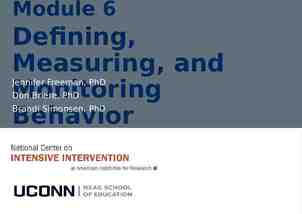UNIT RISK INVENTORIES SELF REPORT SURVEY ADMINISTRATION
15 Slides1.85 MB

UNIT RISK INVENTORIES SELF REPORT SURVEY ADMINISTRATION

TERMINAL LEARNING OBJECTIVE Order, schedule, administer, perform quality assurance, pack/ship, and brief Unit Risk Inventory (URI) and Reintegration Unit Risk Inventory (R-URI) surveys and results 2

ENABLING LEARNING OBJECTIVES Select from a list the differences between a URI and R-URI Describe each survey type (# questions, type of questions, etc) Identify when URI / R-URI should be administered Identify how to request surveys Explain the requirements to submit survey reports to include the minimum number of surveys collected Explain URI and R-URI results 3

THE COMPLETE RISK PICTURE Incidents Reported by Command Channels Unit Risk Inventory (URI) Self-Reported High-Risk Behavior (Survey Info) 4 Reintegration Unit Risk Inventory (R-URI)

URI VERSION 2 (v2) The URI v2: Most current version of the URI survey (should be the only version in use). 53-item anonymous questionnaire that screens for high-risk behavior attitudes that compromise unit readiness. Should be administered to the unit annually. In accordance with the Deployment Cycle Support (DCS) Directive, the URIv2 is required to be administered to Soldiers 30 to 90 days prior to an operational deployment. Although the URI v2 is commonly given to Soldiers before deployment, it can also be administered to non-deploying Soldiers. 5

SELF REPORT SURVEYS Primary purpose of the URIv2: To give commanders a snapshot of unreported high-risk behaviors within the unit. The URIv2 is an anonymous survey. Therefore, the likelihood that Soldiers will honestly answer questions on the survey is increased. The survey must be administered to at least 50% of a unit (to protect anonymity and reinforce honest answers). Survey administrators must also refrain from administering surveys to units with less than twenty Soldiers. The recommended course of action for units with less than twenty Soldiers is to survey the unit at a higher level (e.g., survey at the Battalion level instead of the Company level). An exception to the 50/20 minimum rule can be made on a case-by-case basis, only after other alternatives have been exhausted. Authority must be given by the ASAP RRP Manager. 6

R-URI VERSION 3 The Reintegration Unit Risk Inventory (R-URI) is also an anonymous survey comprised of 80 questions designed to screen for high risk behaviors and suicidal ideations affecting unit readiness that may have occurred during deployment and since returning. In accordance with the Deployment Cycle Support (DCS) Directive, all Soldiers redeploying from Afghanistan, Operation Enduring Freedom, and Operation Noble Eagle are required to complete the R-URI between 30 and 180 days post re-deployment. Version 3 of the R-URI (most recent version) is the only version that should be administered. 7

R-URI VERSION 3 Just like the URIv2, the R-URIv3 survey results are briefed to commanders. The R-URIv3 results are then used to develop initiatives to lessen risky behaviors developed post-deployment. Like the URIv2, administrators of the R-URIv3 must survey at least 50% of the Soldiers who deployed, and may not survey units with fewer than 20 Soldiers (to preserve anonymity and, thereby, increase the chances for honest responses). The recommended course of action for units with fewer than 20 Soldiers is to survey the unit at a higher level (e.g., survey at the Battalion level). An exception to the 50/20 minimum rule can be made on a case-by-case basis, only after other alternatives have been exhausted. Authority can only be given by the ARD ASAP RRP Program Manager. 8

URI AND R-URI ROLL-UP REPORTS URI and R-URI Roll-up Reports allow state, brigade, and battalion commanders to combine the survey results of their subordinate reporting units under a single UIC. As a result, commanders can see how their reporting units are doing as a whole. The URI Roll-up Report sums up the number of positive responses from Soldiers in component units under brigades, battalions, and companies. The URI Roll-up Report then compares that single percentage of positive responses (from the specified component units) to the State and RRP Rate. Again, the URI Roll-up Report only generates percentages of component units that reflect risky behaviors and suicidal ideations developed in a non-deployed status. 9

URI and R-URI Roll-up Reports The R-URI Roll-up Report also converts the number of positive responses from Soldiers in component units (under brigades, battalions, or companies) into a single percentage. The R-URI Roll-Up Report then compares that single percentage to the percentage of positive responses from Soldiers in the same branch class. For example, the percentage of positive responses from Soldiers in Maneuvers, Fires, and Effects (MFE) units will only be compared to the percentage of positive responses from other MFE Soldiers. Again, the R-URI Roll-up Report only generates percentages of component units that reflect risky behaviors and suicidal ideations developed while deployed and since returning. 10

HOW TO ORDER SURVEYS After RRPCs identify units that need to be surveyed, they must schedule and confirm the date of administration with the commander. After the administration date has been confirmed, RRPCs can then determine the number of surveys needed for the units scheduled. URIs and R-URIs come in packs of 250, so it is normal that RRPCs may have an odd number of surveys left over after the date of administration. Plan ahead and keep some extra surveys on hand. ARD ASAP ships surveys out the last week of each month through regular Army mail (APO); surveys should arrived by the 15th of the month. RRPCs should request URI/R-URI surveys through USARC POCs: –[email protected] –[email protected] 11

SHIPPING SURVEYS Before RRPCs send surveys to ARD ASAP, they must attach a completed URI or R-URI cover sheet for each unit. The cover sheet will tell ARD ASAP personnel which report is needed (URI/R-URI Results Report). Other than Installation/Command/State Roll-up Reports, it is essential that the RRPC list EVERY UIC he/she wants included in the roll-up. If omitted, there is no guarantee that all member units of a brigade or battalion will be included. When shipping surveys, rubber band each set of surveys and coversheet together, especially when submitting multiple units. 12

SHIPPING SURVEYS Below is a checklist for RRPCs ordering surveys and sending surveys in for Summary of Results and Roll-up Reports: 1. Do I have enough URIs/RURIs? If not, order proper amount. When surveys are received, inform Mrs. Nguyen or Mr. Damon Goodgion. 2. Schedule survey date, time and venue. Coordinate with unit CDR. 3. Administer survey to at least 50% of unit. If not 50%, get approval from ARD ASAP. 4. Mail surveys to: ARD/ASAP Survey Processing Center Taylor Building (703) 571-7304 2530 Crystal Drive 6th Floor Arlington, VA 22202-3941 13

ENABLING LEARNING OBJECTIVES Select from a list the differences between a URI and R-URI Identify when URI/R-URI Survey should be administered Identify how to request surveys Describe each survey type (# questions, type of questions, etc) Explain the requirements to submit survey reports to include the minimum number of surveys collected Explain URI and R-URI results 14

QUESTIONS Don’t Risk Readiness ! URI CONTACTS: [email protected] [email protected] [email protected] 15






